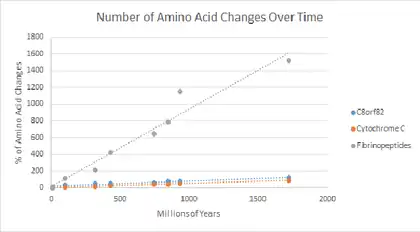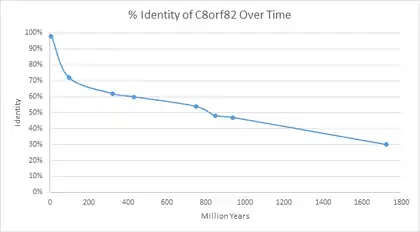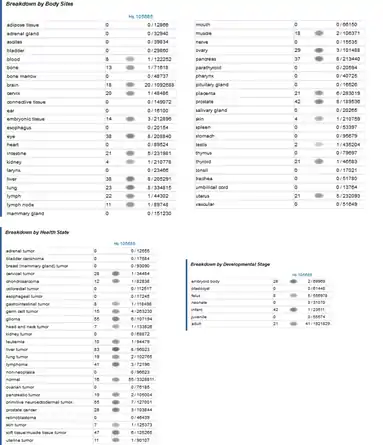C8orf82
Chromosome 8 open reading frame 82 is a protein encoded in humans by the C8orf82 gene.
Gene
C8orf82 is a gene located on the minus strand of chromosome 8 in the species Homo sapiens at locus 8q24. The gene is 3,400 bases long and contains 3 exons.[1]
mRNA
The mRNA produced by the C8orf82 gene is 1,979 base pairs long with coding sequence that starts at base 159 and ends at base 809.[2] According to NCBI Gene there are no alternative transcripts or isoforms.[1] AceView lists several alternative transcripts and isoforms, the existence of which is uncertain.[3]
Homology
C8orf82 is conserved among invertebrates, fish, reptiles, mammals, and protists. C8orf82 was not found to be conserved among bacteria, archaea, plants, fungi, or trichoplax. The domain of unknown function DUF4505 seems to be well conserved among most orthologs.[1]
Orthologs
Below is a table of orthologs obtained using Blast.
| Common name | Genus & species | Date of divergence from humans (MYA) | Accession number | Sequence length (AA) | Sequence identity to humans | Sequence similarity to humans |
|---|---|---|---|---|---|---|
| Chimpanzee | Pan troglodytes | 6.6 | NP_001233407 | 216 | 98% | 98% |
| Little brown bat | Myotis lucifugus | 97.5 | XP_006107626 | 157 | 91% | 92% |
| Wild boar | Sus scrofa | 97.5 | XP_013851838 | 269 | 53% | 56% |
| Peregrine falcon | Falco peregrinus | 320.5 | XP_013149891 | 205 | 70% | 76% |
| Burmese python | Python bivittatus | 320.5 | XP_007436434 | 201 | 64% | 75% |
| Schlegel's Japanese gecko | Gekko japonicus | 320.5 | XP_015273778 | 214 | 65% | 74% |
| Crested ibis | Nipponia nippon | 320.5 | XP_009466919 | 168 | 66% | 72% |
| Rock dove | Columba livia | 320.5 | XP_013226589 | 159 | 59% | 67% |
| Kiwi bird | Apteryx australis mantelli | 320.5 | XP_013800585 | 318 | 55% | 64% |
| Green turtle | Chelonia mydas | 320.5 | XP_007063392 | 188 | 52% | 64% |
| Blind cave fish | Astyanax mexicanus | 429.6 | XP_007255700 | 217 | 63% | 75% |
| Black cod | Notothenia coriiceps | 429.6 | XP_010788219 | 237 | 61% | 71% |
| Sheepshead minnow | Cyprinodon variegatus | 429.6 | XP_015227424 | 166 | 57% | 65% |
| Sea urchin | Strongylocentrotus purpuratus | 747.8 | XP_784244 | 265 | 54% | 72% |
| Swallowtail butterfly | Papilio polytes | 847 | XP_013133745 | 166 | 52 | 72 |
| Honey bee | Apis mellifera | 847 | XP_393829.2 | 220 | 50% | 64% |
| Mite | Metaseiulus occidentalis | 847 | XP_003744318 | 211 | 42% | 60% |
| Sponge | Amphimedon queenslandica | 936 | XP_003384611 | 215 | 47% | 62% |
| Protozoa | Tetrahymena thermophila | 1724.7 | XP_001015777.2 | 208 | 30% | 46% |
| Protist | Thecamonas trahens | ??? | XP_013760738 | 237 | 32% | 44% |
Evolutionary history
C8orf82 does not belong to a specific gene family and has no other known alternative splice isoforms. This holds true for its most distant ancestor as well.[1][4]

The above graph show's how the behavior of C8orf82's percent of amino acid changes over time is similar to that of fibrinogen and vastly different from cytochrome c indicating a very slow rate of change over time.
Below is a graph that depicts the percent identity change of the orthologs listed in the ortholog table based on the orthologs dates of divergence.

Protein
The C8orf82 gene encodes for the protein termed UPF0598 protein C8orf82 or just C8orf82.[4]
General properties
The protein is 216 amino acids long and contains a domain of unknown function DUF4505. This domain of unknown function is also known as pfam14956.[5] The protein has a molecular weight of 23.8 kDa and an isoelectric point of 9.36.[6]
Compositional features
Isoleucine (0.5%) and lysine (1.4%) within C8orf82 were found to occur in lower frequencies compared to other normal human proteins, while proline(9.7%) and arginine (10.6%) had slightly higher occurrence frequencies.[6]
Post-translational modifications
Predicted post-translational modifications based on ExPASy tests include phosphorylation sites at several serines, threonines, and tyrosines. In addition tyrosine sulfation, sumoylation, O-linked glycosylation, O-ß-GlcNAc attachment sites and an NES motif was also detected.[7]

Subcellular localization
C8orf82 is predicted to be localized within the mitochondria using PSORT II analysis. The results of a k-NN prediction attributed 60.9% to mitochondrial localization and 26.1% to nuclear localization.[8]
Interacting proteins
ETFA has been shown to interact with C8orf82 using high-throughput affinity-purification mass spectrometry.[9]
Expression
Using antibody staining, most normal cells showed moderate cytoplasmic and nuclear immunoreactivity. Strong staining was observed in placental trophoblasts. Lymphoid tissues, glial cells and myocytes were weakly stained or negative. A staining analysis was also done on cancer cells and the results were as follows; a majority of malignant cells displayed weak to moderate positivity. Many cases of malignant carcinoids and lymphomas were negative. In all these tests, only a single antibody was used (CAB034331).[10]
Microarray data has shown C8orf82 to be ubiquitously expressed.

An EST profile for C8orf82 also shows ubiquitous expression.

References
- NCBI (National Center for Biotechnology Information) gene entry on C8orf82
- NCBI Nucleotide entry on C8orf82
- AceView entry on C8orf82
- GeneCards entry on C8orf82
- NCBI Protein entry on C8orf82
- SDSC Biology WorkBench 3.2 - Statistical Analysis of Primary Structure tool
- ExPASy Proteomics Tools
- "PSORT II Prediction Analysis". Archived from the original on 2021-07-09. Retrieved 2016-05-09.
- Huttlin EL, Ting L, Bruckner RJ, Gebreab F, Gygi MP, Szpyt J, Tam S, Zarraga G, Colby G, Baltier K, Dong R, Guarani V, Vaites LP, Ordureau A, Rad R, Erickson BK, Wühr M, Chick J, Zhai B, Kolippakkam D, Mintseris J, Obar RA, Harris T, Artavanis-Tsakonas S, Sowa ME, De Camilli P, Paulo JA, Harper JW, Gygi SP (2015). "The BioPlex Network: A Systematic Exploration of the Human Interactome". Cell. 162 (2): 425–40. doi:10.1016/j.cell.2015.06.043. PMC 4617211. PMID 26186194.
- The Human Protein Atlas entry on C8orf82
- NCBI GEO Profile entry on C8orf82 GDS3113
- Unigene entry for C8orf82